The first Hellenic battleships – Before the Kilkis class, there was the Mississippi class. They were the last American pre-dreadnoughts, considered at the time somewhat hybrid ships, not monocaliber but with a powerful secondary artillery, and yet still slow pre-dreadnoughts. The Mississippi and Idaho had already a career in the “great white fleet” before the war, but saw no service during WW1, as instead of being sold for scrap later they were acquired in June 1914, when war was looming again in the Balkans, by Greece.
It was a bold move to acquire such ships for the modest naval power that was Greece at that time. But it’s understandable given the context however. Kilkis and Lemnos became the first Greek batteships and last American pre-dreadnoughts. They had little service however and after limited overhaul in the 1920s were used respectively as a schoolship and reserve coast guard vessel. Both ended their career in the Piraeus under bombs of the Luftwaffe.
Potential Greek Battleships in 1914
Despite having a long rivalry and conflicting history with Turkey, detached from the Ottoman Empire in 1829, the Greek Navy remained a Tom thumb compared to the might of the Ottoman fleet. Over time, the fleet acquired several armoured ships, notably the Ironclads Basilos Giorgios in 1867, Basilissa Olga in 1869, anf the three, more capable Hydra class of 1889. Both cruisers Nauarchos Mialoulis (1879) and Hellas (1861) were certainly vintage, third rate ships, no longer effective when the first Balkan war broke out in 1912.
This had the effect of bringing up a new naval plan, traduced into the search to built a dreadnought, the Salamis class in Germany, while prospects were made to order a Provence class battleship (Basileus Konstantinos) at St Nazaire in April 1914.
The Salamis and Konstantinos were a response to the Ottoman Barbaros Hayreddin and Turgut Reis.
The first was suspended in December 1914, launched in November 1914 only to clear the Blohm & Voss slipway. She was never paid at first and eventually broken up after a long judiciary dispute. Work started on the second on 12 June 1914 but also stopped in August completely and never resumed.
The contract dispute for Salamis started in 1923 when the yard sued the Greek government, and the unfinished vessel was partially paid in 1932 and broken up afterwards, some equipments recycled (like the turret, ending on the HMS Abercrombie and US secondary guns on other ships). The contract was also settled in 1925 for the Konstantinos, whereas little work has been done.
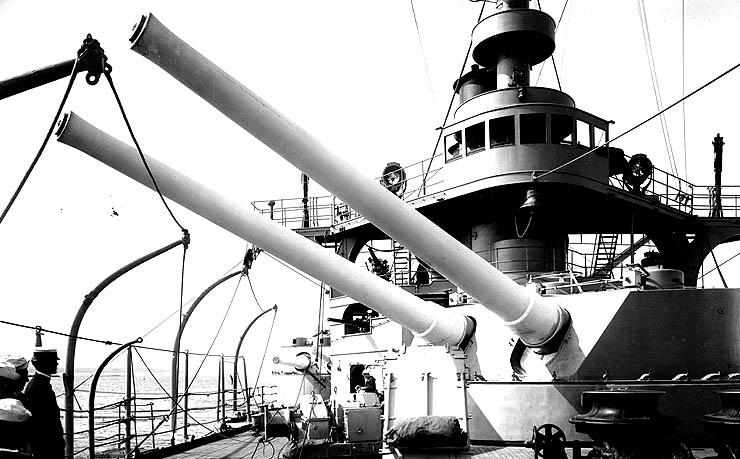
The acquisition of Mississippi class ships
Even before the German and French yards stopped working on their orders, the Greek government desperalty approached the only nation that was at no risk in 1914 to sell one of its own battleship: The Unites States. Since dreadnoughts were the new craze, pre-dreadnoughts fell in disregard in 1914. It was considered by the Greek government to acquire battleships “on the shelf” as rapidly as possible and they thought of the Mississippi class that, stopped in Athens and visited the Balkans in 1912 and left quite an impression. Under no threat of immediate war and with a not-so useful ship on their arms, the US Government gave the greenlight.
The Navy also certainly not opposed to this transfer as both ships were considered badly compromised under Congress severe restriction of tonnage. Therefore Greece purchased them on 23 june 1914 under the names Vassilefs Georgios and Vassilissa Olga for $12,535,277. This was made by using an intermediary, shipbuilder Fred Gauntlett, who acquired them on 8 July and handed them over to Greece. Situation indeed evolved with rising tensions following the assassination of Archduke Franz Ferdinand, and the ships were eventually transferred on 30 July 1914 under the new names of Kilkis and Limnos (or Lemnos). They were commissioned prior to this on 22 July 1914.
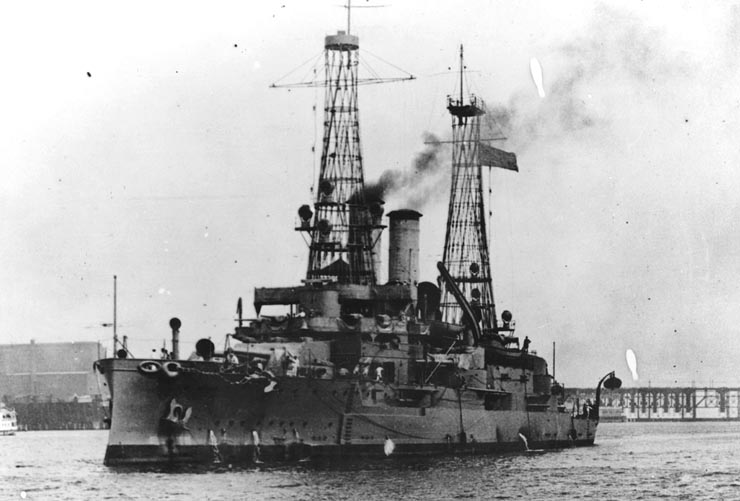
Design of the Mississippi
The Mississippi class battleships originated from the 1903 naval budget, and were the last American pre-dreadnoughts at it was said. They resembled the previous classes (Connecticut, Vermont). They were also smaller than the several preceding classes of US battleships, the Congress trying to stop the natural growth and cost of USN battleships. As a result, the Mississippi were repeats of the Connecticut class with the same armament and armor, but smaller, with a reduced engine and less fuel capacity, almost coastal in nature. Like the Connecticut they used four levels of artillery, main 12-in, secondary 8-in in turrets, tertiary 7-in guns in barbettes, three different calibers for small QF anti-torpedo boat artillery, and torpedo tubes. This complicated artillery management became obsolete and in 1914 getting rid of these unsatisfactory ships by selling them to the Greeks was a way to free budgetary post and some crew for the upcoming dreadnoughts.
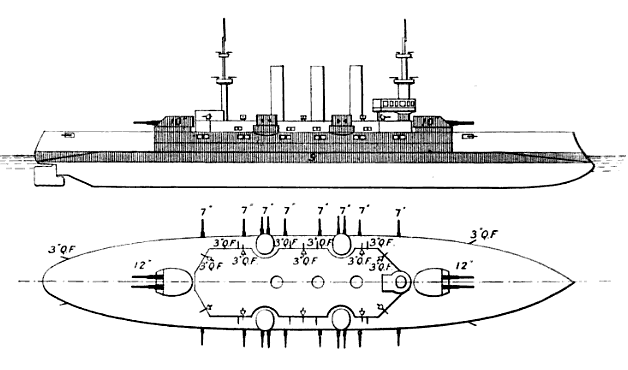
The Mississippi class in detail
The class displaced 13,000 long tons (13,000 t) as designed and 14,465 long tons (14,697 t) fully loaded, for a hull length of 382 ft (116.4 m), a Beam of 77 ft (23.5 m) and draft 24 ft 8 in (7.5 m). For propulsion, they relied on two propellers mated to triple expansion steam engines, fed by eight Babcock & Wilcox boilers rated for 10,000 ihp (7,500 kW) total.
This gave a top speed of 17 knots (31 km/h; 20 mph). Their crew of 744 needed to manage a considerable diversity in armament: four 12-inch (305 mm) guns, eight 8-inch (203 mm) guns, eight 7-inch (178 mm) guns, but also twelve 3-inch (76 mm) guns, six 3-pounder guns, and two 1-pounder guns against torpedo boats plus the usual two 21-inch (533 mm) hull broadside torpedo tubes.
Protection wise, they were “light” due to tonnage limitations, however with plates made of Krupp and Harvey steel. They were given a 9 in (229 mm) thick armoured belt on the central section, 178 mm down to 102 mm at ship ends) while the main turrets were protected by a frontal 12 in (305 mm) armor. The Conning tower had 9 in (229 mm) thick walls. The Bulkheads were 178 mm thick, and the main gun barbettes 254 mm down to 152 mm, medium gun turrets 164 mm for the frontal arc down to 51 mm on the roof, the medium gun barbettes were 152 mm thick, the casemates were also 178 mm thick, the decks were 37 mm with thick 76mm slopes.
Not the best battleships around
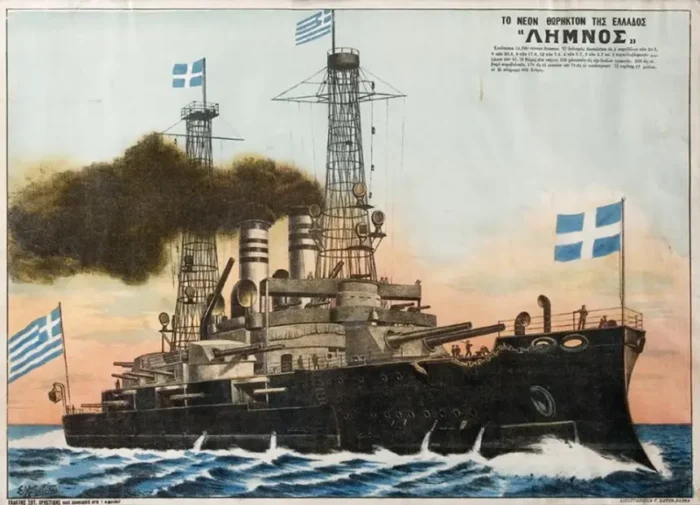
The choice of these battleships was based on their recent character, yet of a class the US Navy did not wanted to keep. It was relatively unfortunate as these battleships, as the last pre-dreadnoughts of the USN followed the path of late pre-dreadnought, mixing a heavy secondary armament to their main artillery.
The dropside of it was a more complicated targeting management, seeing relatively close splashes, therefore not being able to differentiate the 305, 203 and 178 mm guns. Compounded to this, the Congress imposed a tonnage reduction in 1903 when the naval law was adopted and the ships planned. In the end both ships did not found many uses in the Greek fleet and were soon mothballed.
Active carrer of the Kilkis and Lemnos
Both ships after acquisition spent some time in reserve as the new King Constantine I was pro-German. He was not favourable to any military involvement in the war, and the Navy did not found many uses for it. Indeed Greece was maintained neutral until 1917. Kilkis was flagship of the Greek Navy. On 19 October 1916, the French Navy seized the Hellenic fleet and Kilkis was reduced to a skeleton crew, with the breech blocks removed to be unable to fire. Ammunitions and torpedoes were also removed. The pro-entente government replaced Constantine and declared war to the central powers. Nevertheless, Kilkis did not saw active service. She was used only as a harbour defence ship.
However after the war ended, the Russian Civil War of 1919 motivated the requisition of the Kilkis in the Black sea, and she was used to support allied ships at Sevastopol. From the same year, the Greek-Turkish war, Kilkis supported the landings to seize Ottoman territories around Smyrna and around, escorting several ships carrying troops.
The Greek battleship carried Admiral Kaloulides, later the governor of the city. After the internment of the Ottoman city, there was no serious threat left for the Greek City. The Kilkis stationed at Constantinople and the crews trained to landing practices and support of ground troops. Kilkis participated later in the Spithead naval review honoring King Georges V. Kilkis and a pair of destroyers escorted troops to Panderma.
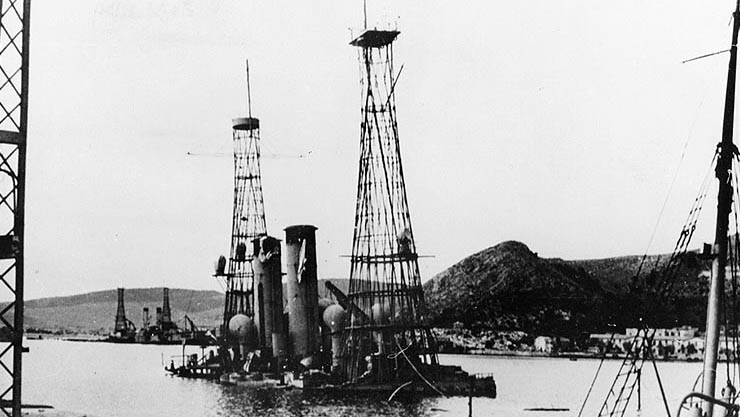
Kilkis assisted the cruiser Giorgios Averof, and sailed with Aetos, Leon, Ierax and a hospital ship. Landings took place at Eregli on the other side of the sea of Armora. In July, Kilkis departed with troopships and the HMS Ark Royal to cover operations with the Greek Forces and operations until September 1922. Eventually the city was evacuated and Kilkis and Lemnos participated in rembarking troops and departing in September 1922.
From 1926 to 1928 both ships were sent in drydock for repairs and overhaul. The main goal was to replace the worn-out boilers tubes. However barely one year after in 1929, the Hellenistic fleet announced the ship was to be retired from service and broken up. She was replaced by the Giorgios Averof as flagship. However it was decided to wait until 1932 to discard her. But Kilkis still was not discharged. It was decided to convert her as a school ship for AA gunners.
Meanwhile, Lemnos was disarmed by the French in 1916 and kept a skeleton crew for operation. However she was rearmed quickly under the new government of Prime Minister Eleftherios Venizelos, when swapping on the side of the entente. Like Kilkis she participated in 1919 to the Allied Crimean intervention in the Russian Civil War. She notably covered Kaffa Bay, in support to the Volunteer Army, and later Lemnos and the British HMS Caradoc bombarded the town of Vladislovovka to prevent “Red” renforts.
Later this year she also covered many landings at the beginning of the Greco-Turkish War. In February 1921, Lemnos was stationed in Smyrna, providing close support. She also carried out the evacuation of the city by September 1922. On her way back, Lemnos Captain, Dimitrios Fokas, formed a Revolutionary Committee with colonels Nikolaos Plastiras and Stylianos Gonatas in support of Venizelos, recently ousted from power. They launched 11 September 1922 Revolution, soon joined by other vessels of the Navy.
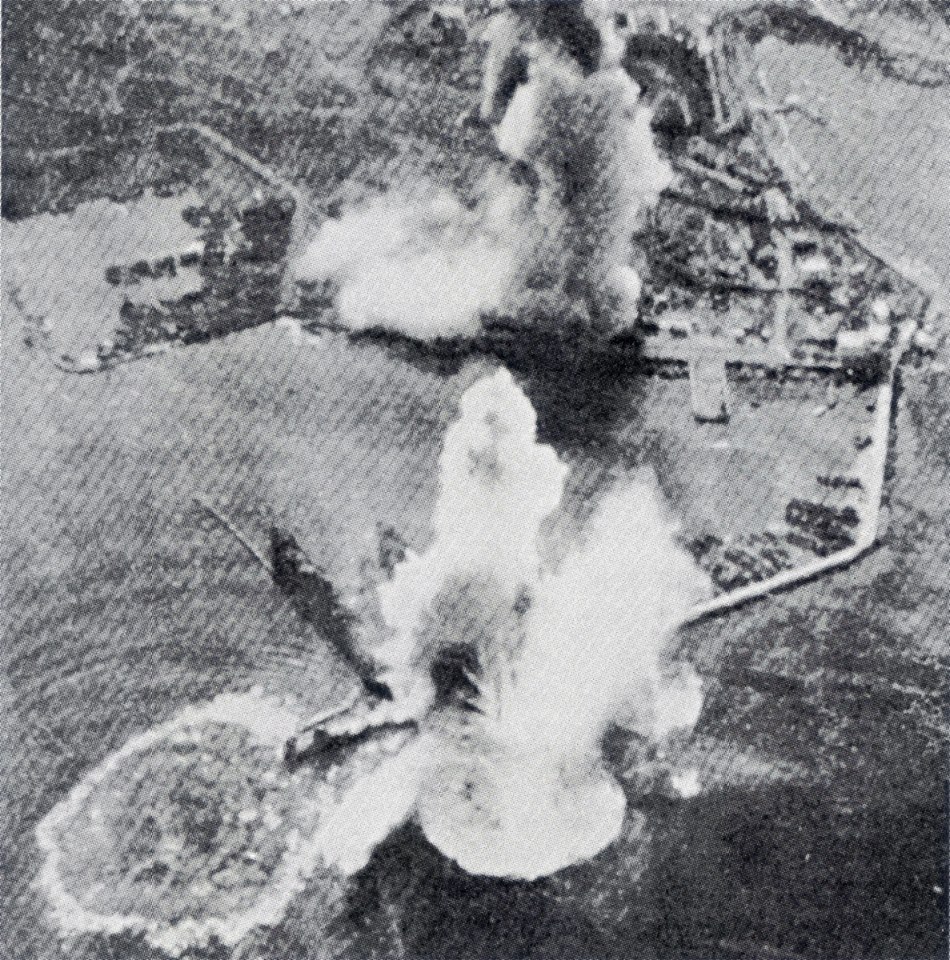
In 1932 Limnos was placed in reserve, and later part of her armor was retired to be placed on the fortifications on the island of Aegina. She stayed partially disarmed in state of semi-reserve until 1937, and then totally disarmed, and converted later into a stationary hulk and barracks ship.
Kilkis after being reactivated 1935 and temporarily commissioned again to serve with Averof, lost her light guns, but kept her basic armament to be used as a gunnery drill hulk. On 23 march 1941 Kilkis and Limnos were both anchored in Pireus when the second world war broke out and the German invasion in April 1941.
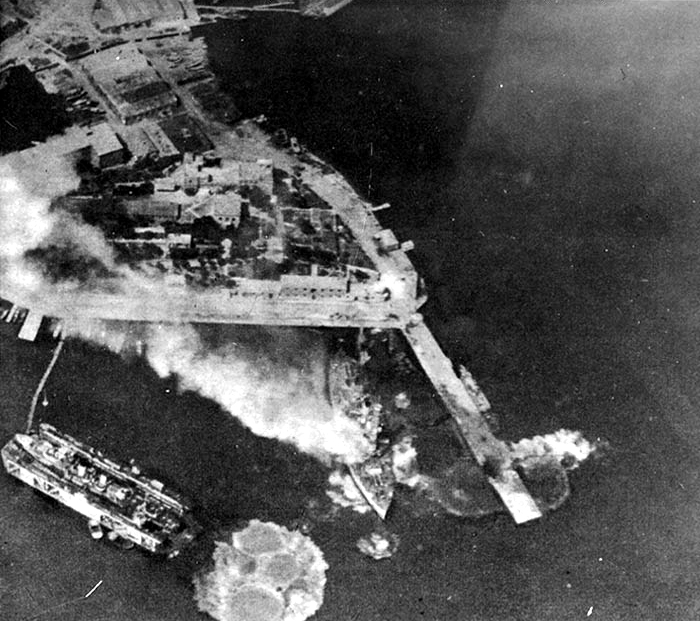
The floating dock and destroyer were also sunk (reportedly on 20 April ?), but Vasilefs Georgios was subsequently raised and placed in service by the German Navy as Hermes (ZG-3). Photograph and some caption information were provided by Franz Selinger. U.S. Naval Historical Center Photograph.
They were almost totally disarmed, most of their guns used in coastal batteries throughout Greece. On 23 April at Salamis the Luftwaffe attacked the Piraeus, Salamis naval base and sank the Kilkis. Aerial Color photos of the time showed Kilkis vertical surfaces including the turret roofs, conning tower roof and possibly some decks were camouflaged in an intricate pattern of brown-green splatches.
She took several 500 kgs bombs from Ju 87 Stukas dive bombers, but her crew tried to have her underway to evade these, without luck. Her crew managed to beach her nearby and she still emerged. Her wreck was broken up after the war. Lemnos was apparently sunk the day after on 24/4/1941 on the other side of the harbour. Photos shows their relative positions indeed.
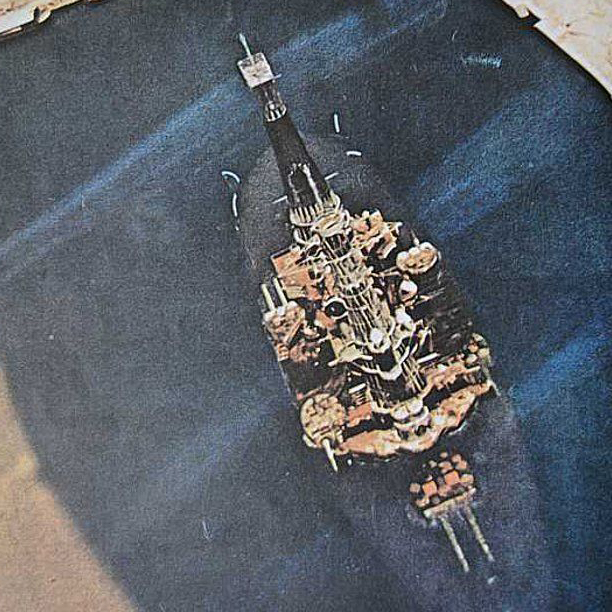
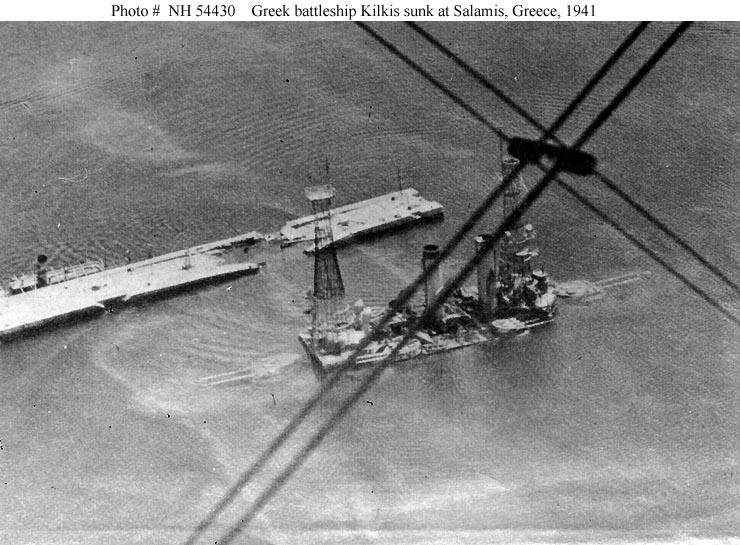
Specifications
-Displacement: 13 200t, 14 460t
-Dimensions: 116.4m x 23,5m x 7,5m
-Propulsion: 2 shafts VTE, 12 boilers 10,000 hp. 17 knots max.
-Armour: see notes
-Armement: see notes
Read More
//en.wikipedia.org/wiki/Greek_battleship_Kilkis
//en.wikipedia.org/wiki/Mississippi-class_battleship
//www.navypedia.org/ships/greece/gr_bb_kilkis.htm
//www.ww2wrecks.com/portfolio/the-story-of-the-greek-battleship-kilkis-sunk-by-stuka-bombers-on-april-23-1941/
//ww2aircraft.net/forum/attachments/april2341a-jpg.341822/

Rendition profile of the Kilkis in 1941



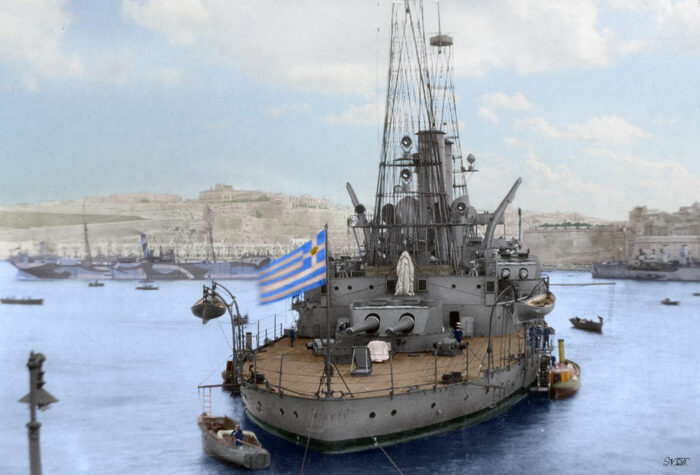
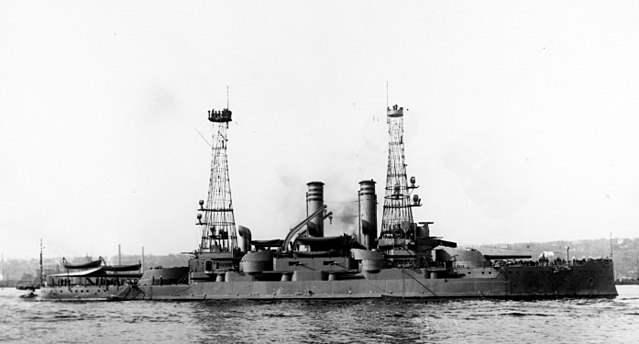
 Latest Facebook Entry -
Latest Facebook Entry -  X(Tweeter) Naval Encyclopedia's deck archive
X(Tweeter) Naval Encyclopedia's deck archive Instagram (@navalencyc)
Instagram (@navalencyc)





 French Navy
French Navy Royal Navy
Royal Navy Russian Navy
Russian Navy Armada Espanola
Armada Espanola Austrian Navy
Austrian Navy K.u.K. Kriegsmarine
K.u.K. Kriegsmarine Dansk Marine
Dansk Marine Nautiko Hellenon
Nautiko Hellenon Koninklije Marine 1870
Koninklije Marine 1870 Marinha do Brasil
Marinha do Brasil Osmanlı Donanması
Osmanlı Donanması Marina Do Peru
Marina Do Peru Marinha do Portugal
Marinha do Portugal Regia Marina 1870
Regia Marina 1870 Nihhon Kaigun 1870
Nihhon Kaigun 1870 Preußische Marine 1870
Preußische Marine 1870 Russkiy Flot 1870
Russkiy Flot 1870 Svenska marinen
Svenska marinen Søværnet
Søværnet Union Navy
Union Navy Confederate Navy
Confederate Navy Armada de Argentina
Armada de Argentina Imperial Chinese Navy
Imperial Chinese Navy Marinha do Portugal
Marinha do Portugal Mexico
Mexico Kaiserliche Marine
Kaiserliche Marine 1898 US Navy
1898 US Navy Sovietskiy Flot
Sovietskiy Flot Royal Canadian Navy
Royal Canadian Navy Royal Australian Navy
Royal Australian Navy RNZN Fleet
RNZN Fleet Chinese Navy 1937
Chinese Navy 1937 Kriegsmarine
Kriegsmarine Chilean Navy
Chilean Navy Danish Navy
Danish Navy Finnish Navy
Finnish Navy Hellenic Navy
Hellenic Navy Polish Navy
Polish Navy Romanian Navy
Romanian Navy Turkish Navy
Turkish Navy Royal Yugoslav Navy
Royal Yugoslav Navy Royal Thai Navy
Royal Thai Navy Minor Navies
Minor Navies Albania
Albania Austria
Austria Belgium
Belgium Columbia
Columbia Costa Rica
Costa Rica Cuba
Cuba Czechoslovakia
Czechoslovakia Dominican Republic
Dominican Republic Haiti
Haiti Hungary
Hungary Honduras
Honduras Estonia
Estonia Iceland
Iceland Eire
Eire Equador
Equador Iran
Iran Iraq
Iraq Latvia
Latvia Liberia
Liberia Lithuania
Lithuania Mandchukuo
Mandchukuo Morocco
Morocco Nicaragua
Nicaragua Persia
Persia San Salvador
San Salvador Sarawak
Sarawak Uruguay
Uruguay Venezuela
Venezuela Zanzibar
Zanzibar Warsaw Pact Navies
Warsaw Pact Navies Bulgaria
Bulgaria Hungary
Hungary

 Bundesmarine
Bundesmarine Dutch Navy
Dutch Navy Hellenic Navy
Hellenic Navy Marina Militare
Marina Militare Yugoslav Navy
Yugoslav Navy Chinese Navy
Chinese Navy Indian Navy
Indian Navy Indonesian Navy
Indonesian Navy JMSDF
JMSDF North Korean Navy
North Korean Navy Pakistani Navy
Pakistani Navy Philippines Navy
Philippines Navy ROKN
ROKN Rep. of Singapore Navy
Rep. of Singapore Navy Taiwanese Navy
Taiwanese Navy IDF Navy
IDF Navy Saudi Navy
Saudi Navy Royal New Zealand Navy
Royal New Zealand Navy Egyptian Navy
Egyptian Navy South African Navy
South African Navy






























 Ukrainian Navy
Ukrainian Navy dbodesign
dbodesign